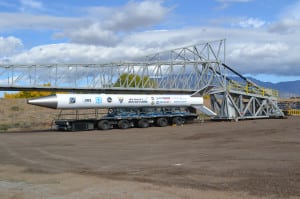
A scale model of the Super Strypi rocket attached to the rail launcher. Photo: Sandia National Laboratories
[Via Satellite 07-10-2015] Several companies have expressed interest in commercializing the Super Strypi dedicated small satellite launch vehicle currently under development by the U.S. Air Force Operationally Responsive Space (ORS) office. Speaking July 10 at a Mitchell Institute for Aerospace Studies event, Colonel John Anttonen, director of ORS, said the rail-launched rocket has attracted the attention of industry, which could use the rocket to conduct launches for both the military and commercial sector.
ORS recently sent out a Request for Information (RFI) to industry inviting them to witness and participate in launch activity. Anttonen said ORS wanted industry participants in order to give companies a chance to see how it conducts operations on the launch side. That effort has helped draw interest in the Super Strypi launch system, which is slated for its first demonstration mission later this year.
“We wanted them to be partners in this because we want this to be commercial. We’ve had interest,” said Anttonen. “A number of companies are going to participate with us in that. And a number of those companies are going to take those data packages and go off and hopefully turn those into fully commercial systems.
Super Strypi is designed to launch low mass payloads to Low Earth Orbit (LEO) at a price point of $15 million. ORS, now part of Air Force Space and Missile Systems Center (SMC), is developing the launch system together with Aerojet Rocketdyne, Sandia National Laboratories, the University of Hawaii, and the Pacific Missile Range Facility. ORS is hoping that the completed system will give the U.S. Department of Defense (DOD) a means of buying launch services from a commercial operator for dedicated small satellite missions.
“The entire intent of Super Strypi was to commercialize it and get it turned over to industry. We intentionally went in with the data packages of the entire rocket system, and we’re making all that available to industry. We want them to go build these things, and we do think there is a market for small satellite launch,” said Anttonen.
ORS hopes the Super Strypi will not only meet government needs, but also service the burgeoning small satellite sector. Anttonen said the rocket is designed for a launch cadence of around 10 missions per year.
The Super Strypi rocket has fallen behind schedule, with first launch previously anticipated in 2014. Anttonen said the ORS-4 demonstration mission is now slated for October. Super Strypi uses three new solid rocket motors for its flight. Aerojet Rocketdyne completed a 73-second test of the first stage solid propellant rocket motor (LEO-46), known as the Low Earth Orbiting Nanosatellite Integrated Defense Autonomous System (LEONIDAS) at the Air Force Research Laboratory (AFRL) at Edwards Air Force Base in California last year. The company completed motor ground test demonstrations of the LEO-7 second stage motor and the LEO-1 third stage motor in August 2012 and September 2013, respectively.
When the Super Strypi does launch, Anttonen said much of the operations will be streamlined thanks to the design, the rail launch system it employs, and its method of assembly.
“Putting all the stages together out on a launch stand assembly can take a long time. I don’t have to do that. I can assemble the whole thing, and just push it onto the rail and it elevates itself. That really simplifies my operations … we literally drag the entire rocket out of the hangar all assembled, we slide it onto the rail and then we drive away. It really makes it a lot easier for operations,” said Anttonen.
The rocket does not need a flight termination system since it has a fixed trajectory with the rail. Furthermore, it is spin-stabilized using fins, which Anttonen said reduces the cost of the avionics systems. The rocket borrows techniques from 1960s rockets to keep the system as simple as possible, he said. These methods help reduce the cost of range operations, which ORS set a goal of halving. Anttonen said range operation costs typically run from $3 million to $5 million, and that ORS’ goal with Super Strypi is to get that below $2 million.
The post Launch Providers Step up to Commercialize ORS Super Strypi appeared first on Via Satellite.